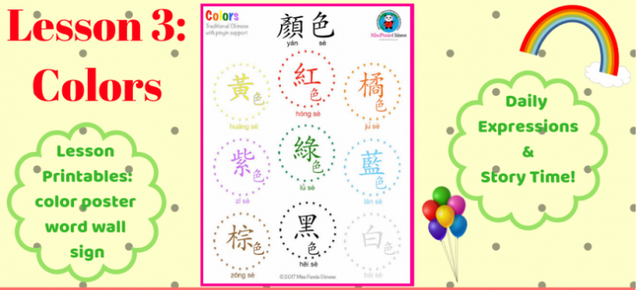Welcome back to another playful class for Mandarin Chinese.
You now have a basic understanding of Chinese language. We have talked about the Chinese tones, the writing systems, and many surprising facts about Chinese language in the Introduction article with the Chinese Starter Kit.
We also touched on how to set up your bilingual home with visual tools that you can display around your house. Do you have a Chinese Word Wall by now?
The last Chinese lesson was with Chinese numbers and counting. This time we are going to talk about colors in Chinese! After this class you will know the Chinese colors and be able to connect numbers and counting with colors with the Chinese language.

Make sure to download the printables at the end of the post!
So, here we go!
Colors -Traditional Chinese
紅色。hóng sè。red
橘色。jú sè。orange
黃色。huáng sè。yello
綠色。lǜ sè。green
藍色。lán sè。blue
紫色。zǐ sè。purple
棕色。zōngsè。brown
黑色。hēi sè。black
白色。bái sè。white
Colors – Simplified Chinese
红色。hóng sè。red
橙色。chéng sè。orange
黃色。huáng sè。yello
绿色。lǜ sè。green
蓝色。lán sè。blue
紫色。zǐ sè。purple
棕色。zōngsè。brown
黑色。hēi sè。black
白色。bái sè。white
Tips for teaching Chinese colors
Language and culture go hand in hand. When we talk about colors in Chinese there are a couple of fun facts that we can introduce to children.
Red is a lucky color for Chinese. Red is the color Chinese people use for wedding, birthday celebration and festival displays.
Do you know there is a special color for Chinese emperors? Yellow was the emperor’s color in ancient China.
Colors of the Rainbow rhyme is a great way to teach and learn the basic colors in Chinese.
Most of the time Chinese color words come with the word “color” at the end. That means red is “red color.” Yellow is “yellow color.”
However, color words can be also used without the “color” word at the end, just like in the rainbow color rhyme.
There are games like “I Spy” and “Music Chairs” that work very well with this color lesson. You can read more in the Teaching Tips page.
Visual Display
I cannot emphasize enough about visual display in your home or in a language classroom, especially when teaching Chinese colors.
Word signs, word walls and posters are providing a text-rich target language environment for children.
This time I have a color poster with pinyin and English support for you to add to your Chinese Word Wall.
Daily Expressions
In the number and counting lesson we use the expression “I see…”. Now, you can use it for colors.
In this lesson I have five sentences that you can use any time of the day when want to have some fun with colors! Use them for “I Spy” game as well.
They are: What color is it? This is ____ (insert color). S/He likes _____. I see _____. Red apple(s).
These expressions are used all the time. You can print them out and post it on your Word Wall. It will come in handy.
Hands-On Activities
This is always my students’ favorite part. Kids of all ages enjoy hands-on learning experience. When children touch, feel, see, hear and make. They are in!
They are in the target language. They are acquiring the language.
Find more related articles here:
https://blog.lingobus.com/learn-chinese/2019-best-way-learn-chinese-vocabulary/
https://blog.lingobus.com/chinese-learning-resources/15-easy-learn-chinese-songs-kids/
https://blog.lingobus.com/chinese-learning-resources/16-chinese-cartoons-for-kids-learn-mandarin/
Congratulations @cherry-zhang! You received a personal award!
You can view your badges on your Steem Board and compare to others on the Steem Ranking
Do not miss the last post from @steemitboard:
Vote for @Steemitboard as a witness to get one more award and increased upvotes!
Downvoting a post can decrease pending rewards and make it less visible. Common reasons:
Submit